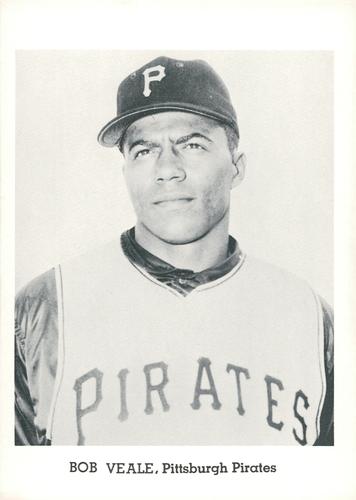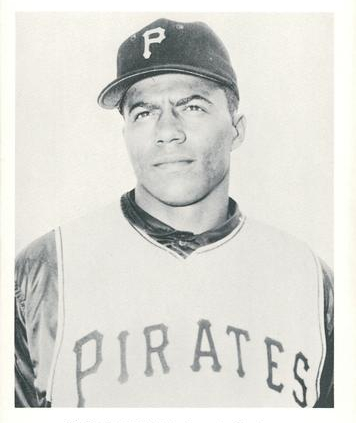July 23, 1959: Bob Veale fans 14, overcomes 9 walks in Class B no-hitter
 When one thinks of baseball’s hardest-throwing starting pitchers in the 1960s, several names immediately come to mind: Bob Gibson, Sam McDowell, Sandy Koufax, and Don Drysdale.
When one thinks of baseball’s hardest-throwing starting pitchers in the 1960s, several names immediately come to mind: Bob Gibson, Sam McDowell, Sandy Koufax, and Don Drysdale.
Often overlooked is Bob Veale, the Pittsburgh Pirates southpaw who burst on the scene as a 28-year-old in 1964 to lead the National League with 250 strikeouts and then set a Bucs record with 276 punchouts the following season. With a screeching fastball and struggles with control – he led the NL in walks four times in five seasons from 1964 through 1968 – the 6-foot-6, bespectacled Veale struck fear in the hearts of opponents. “I was a power pitcher,” recalled Veale, “and I was all over the place. You might get it inside two feet or outside. Wildness can be beneficial to a pitcher.”1
Veale fanned at least 10 batters in a game 34 times in his major-league career and tossed a one-hitter and five two-hitters. Here’s the story about his only no-hitter, which he authored just over a year after turning professional.
Born and raised in Birmingham, Alabama, Veale played in various industrial leagues and pitched in the early 1950s for the Negro American League Birmingham Black Barons, where he attracted the attention of Pirates area scout Buddy Hancken. When Veale went to Atchison, Kansas, to play baseball and basketball on an athletic scholarship at St. Benedict’s College,2 Hancken and the Pirates followed his progress and eventually signed him during his senior year in the spring of 1958.
Assigned in midseason to Las Vegas, the Pirates’ affiliate in the Class C California League, Veale scuffled (2-6, 5.43 ERA), but his 74 strikeouts in 63 innings suggested to the Pirates that they had a diamond in the rough. At the conclusion of the minor-league season, the Pirates invited their top prospects to Pittsburgh to train with Pirates coaching staff; Veale was the only Class C ballplayer3 in the cohort of about two dozen players.4
Veale participated in the Pirates’ big-league spring training in Fort Myers, Florida, in 1959, and was subsequently assigned to the Wilson Tobs in the Class B Carolina League.5 He got off to a strong start, winning seven of his first nine decisions, including an overpowering 15-strikeout performance against the Greensboro Yankees on May 15.6 “[Veale] has outstanding stuff,” raved Tobs skipper Harding Peterson. “He can beat anyone when he gets the ball over. He could be outstanding in the major leagues.”7 Pirates farm director Branch Rickey Jr. called the 23-year-old Veale the “best major league” prospect on the Tobs.8
Veale came down with a sore arm soon after his gem against Greensboro. Expected to be sidelined for two weeks, he ultimately missed a month. He took the mound on July 16, shucked off the rust, and once again dominated the Yankees, tossing a two-hitter and punching out 16.9
On July 22 the Tobs arrived in Raleigh for a two-game set with the Capitals, a Red Sox affiliate. While both clubs had identical 52-37 records,10 Raleigh boasted the circuit’s most potent offense. The Capitals led the league with a .272 batting average and featured one of the best all-around players in the minor leagues, Carl Yastrzemski, batting a league-high .386.11 Propelled by the 19-year-old Yastrzemski’s 2-for-3 performance, the Capitals took the first game, 8-4, to move into sole possession of first place.12
On a hot and muggy Thursday evening in the middle of tobacco country,13 a crowd of 1,412 – about double the season average attendance – packed the wooden grandstand at Devereux Meadow Field on the near north side of the city. Built in 1938, the ballpark had been home of minor-league ball in Raleigh since 1945.
Notwithstanding Veale’s no-hitter, the most remarkable aspect of the game was the number of baserunners. The teams combined for 21 walks and an error (by Raleigh); 19 men were left on base. The Tobs managed only two hits in what unfolded as a tense pitching duel.
The Tobs’ hits and runs were confined to the third inning, off 26-year-old right-hander Ben Tench, who was in his second professional season. With Elder White on first via a walk, the Tobs’ most productive hitter, George Watt, belted a home run.14 Ray Looney laced a two-out single with two on, driving in Corky Glamp for the third run. Tench departed after six innings, charged with three earned runs; he fanned seven and walked nine. Walter Payne struck out three and issued three bases on balls in two innings of relief. The Tobs stranded 10 runners.
With so many runners on base – by both teams – fans might be forgiven if they did not notice that Veale was working on a no-hitter. His nine walks were clustered in just four innings, but he was able to escape each jam. Veale walked the bases full in the second and fanned the side. He fanned the side again in the fifth while working around two walks. In both the seventh and eighth innings he walked two batters.
Veale punched out every batter in Raleigh’s lineup except Hal Holland; Yastrzemski, who finished the season with just 49 whiffs in 538 plate appearances, fanned three times. The Capitals managed to hit only two balls out of the infield, both late-game fly outs to right fielder Larry Elliot.
Veale completed his no-hitter in 2 hours and 40 minutes. It was the first no-hitter by a Tobs pitcher since the team relocated from Kinston to Wilson, about 50 miles east of Raleigh, in May 1952. There had been three previous no-nos in the history of professional baseball in Wilson: William Koy (1942) in the Class D Bi-State League and Red Benton (1946) and Max Wilson (1947) in the Class D Coastal Plain League.
Veale finished the season with a 12-5 record and a 3.45 ERA, led the league in both strikeouts (187) and walks (126) in just 147 innings, and was named to the league all-star team. Joining him was Yastrzemski, the Carolina League MVP and batting champ (.387). While player-manager Ken Deal’s Capitals took the regular-season title by 6½ games over the Tobs, Wilson won the league title, sweeping Raleigh in four games in the Shaughnessy playoff tournament.
In 1960 Veale was bumped up to the Pirates’ top farm club, Triple-A Columbus, where he spent most of the next three seasons working on his control. After early- and late-season trials with the Bucs in 1962, Veale earned a permanent spot on the staff in 1963, posting a minuscule 1.04 ERA in 77⅔ innings as a reliever and spot starter. The following season he led the majors in strikeouts and established himself as a frontline starter.
Eventually earning two All-Star berths, Veale averaged 15 wins, 241 innings pitched, and 214 strikeouts per season from 1964 through 1970. He suffered from arm problems after that and spent his final four major-league seasons (1971-1974) pitching solely in relief, contributing to the Pirates’ 1971 World Series title team and winding up his career as Yastrzemski’s teammate with the Red Sox. Veale finished with a 120-95 record in 13 big-league seasons.
Acknowledgments
This article was fact-checked by Kevin Larkin and copy-edited by Len Levin.
Sources
In addition to the Sources cited in the Notes, the author consulted the Baseball-Reference.com and Retrosheet.org websites for pertinent material and the box scores.
All game information, such as hits and walks, is from “Wilson’s Veale Hurls No-Hitter Against Raleigh,” Raleigh News and Observer, July 24, 1959: 17.
Notes
1 Bob Veale in Twin Killing: The Bill Mazeroski Story, quoted from Bill James and Rob Neyer, The Neyer/James Guide to Pitchers (New York: Fireside, 2004), 412.
2 In 1971 St. Benedict’s College, a men’s college, merged with Mount St. Scholastica College, a women’s college, and became known as Benedictine College. “Our Benedictine Heritage,” Benedictine College Website, accessed April 28, 2023, https://www.benedictine.edu/about/heritage/index.
3 At the time, Class C was the fifth-lowest of seven minor-league levels.
4 “Pirates Hold Special Classes for 24 Minor Loop Prodigies,” The Sporting News, September 10, 1958: 25.
5 Les Biederman, “Joe L. Sees Gibbons Glitter, Adds Him to Buc Camp List,” The Sporting News, January 28, 1959: 13.
6 “Minor League Highlights. Class B,” The Sporting News, May 27, 1959: 35.
7 Joe Tiede, “Tob Manager High on Pitching Staff,” Raleigh News and Observer, July 5, 1959: II, 3.
8 Dwight Fredy, “Short Clips,” Gastonia (North Carolina) Gazette, July 28, 1959: 11.
9 “Minor League Highlights. Class B,” The Sporting News, July 29, 1959: 37.
10 Records from “Carolina League. The Standings,” Raleigh News and Observer, July 23, 1959: 17.
11 Statistic from “Carolina League Averages,” Burlington (North Carolina) Daily Times News, July 25, 1959: 11 [Through games of July 21].
12 Dick Herbert, “Raleigh Regains First in League,” Raleigh News and Observer, July 23, 1959: 17.
13 “The Weather,” Raleigh News and Observer, July 24, 1959: 2
14 In his second and final season in Organized Baseball, Watt slashed 12-74-.323 in 337 at-bats with Wilson in 1958. Promoted to Class A later in 1958, he struggled (2-12-.205).
Additional Stats
Wilson Tobs 3
Raleigh Capitals 0
Devereux Meadow Field
Raleigh, NC
Corrections? Additions?
If you can help us improve this game story, contact us.


